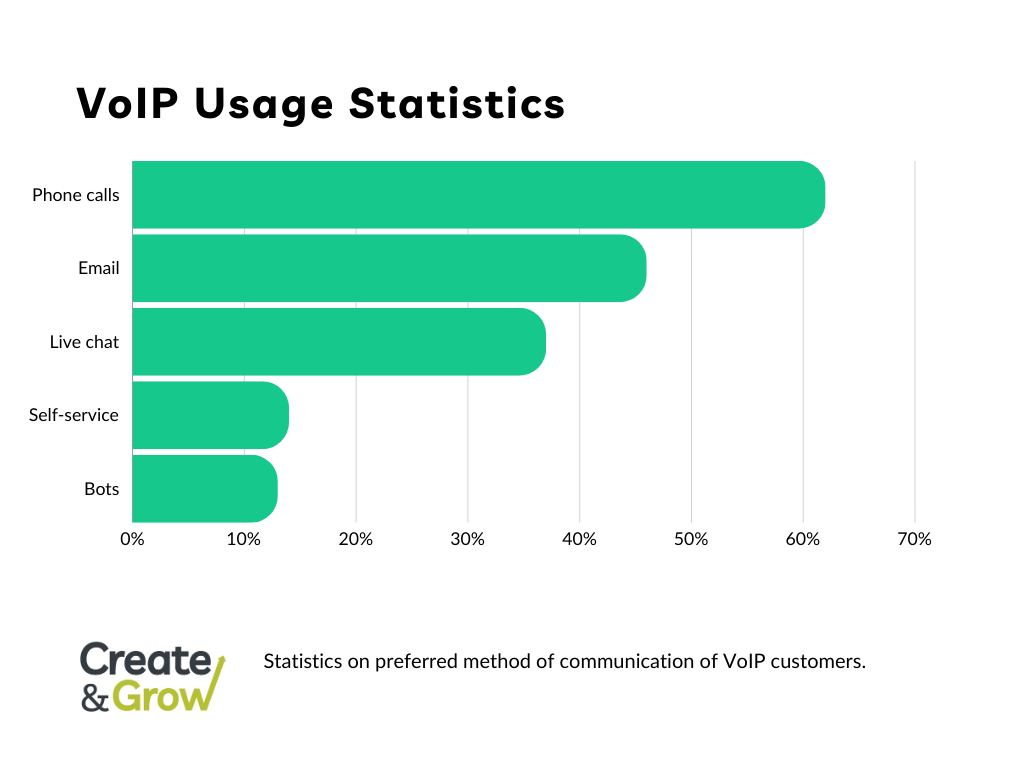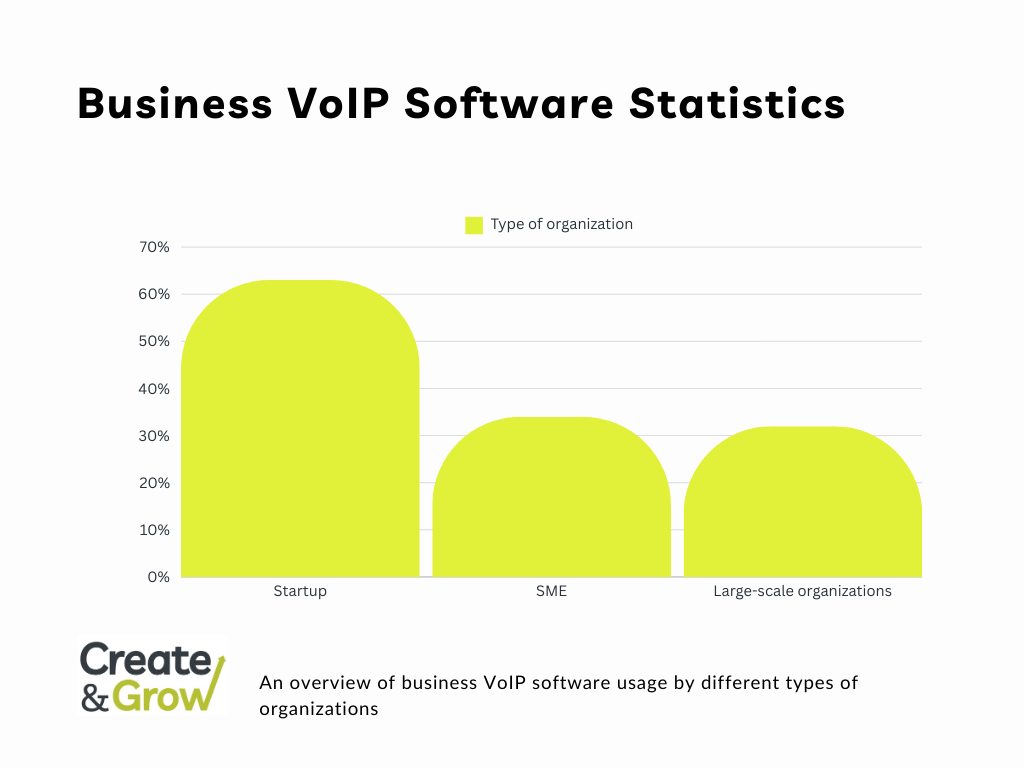General VoIP Market Statistics
- According to the Global VoIP growth report by Research and Markets, the projection for VoIP services suggests they will reach a worth of $102.5 billion by 2026, compared to approximately $85.2 billion in 2021, signifying a Compound Annual Growth Rate (CAGR) of approximately 3.8% during this period. (Source: Findstack)
- The global VoIP market is experiencing an annual growth rate of approximately 21.7%. (Source: Headphones Addict)
- The unified communications market worldwide had a valuation of USD 136.11 billion in 2023, with a projected Compound Annual Growth Rate (CAGR) of 17.4% anticipated from 2023 to 2030. (Source: Grand View Research)
- The market for VoIP services, encompassing provisioning and management within the VoIP industry, is poised to achieve a valuation of $194.5 billion by 2024, with “managed IP” services projected to be the prevailing service, as reported by Persistence. (Source: Findstack)
- With the VoIP market on the rise, the adoption of hosted PBX solutions is projected to surge, with Markets and Markets anticipating Hosted PBX technology to reach approximately $9.5 billion by 2023, up from $4.19 billion in 2018, reflecting a Compound Annual Growth Rate (CAGR) of 14.9%. (Source: Findstack)
- From 2014 to 2024, the global mobile VoIP market size by region is displayed, with a 2017 prediction of the European market reaching $14 billion. VoIP enables phone calls resembling traditional networks. (Source: Statista)
- The North America VoIP market is expected to maintain a commanding industry share, exceeding 40% by 2025, driven by the widespread adoption of cloud services, the presence of advanced telecommunications infrastructure, and the growing popularity of workforce mobility. (Source: Global Newswire)
- Approximately 60% of smartphone users utilize Google to search for a business number and call it directly. (Source: Enterprise Today)
- A majority of businesses, 52%, regard the telephone as their primary communication tool. (Source: RingCentral)
VoIP Mobile Market Statistics
- Anticipated at a CAGR of more than 20%, the video conferencing segment is poised for growth from 2016 to 2024. (Source: Grand View Research)
- The Android OS is projected to reign supreme, reaching a market share of over USD 90 billion by 2024. (Source: Grand View Research)
- Asia Pacific is set to be the swiftest-expanding region, with a projected CAGR of over 23% between 2016 and 2024. (Source: Grand View Research)
- The mobile VoIP market is anticipated to achieve a value of USD 145.76 billion by the year 2024. (Source: Enterprise Today)
VoIP Usage Statistics
- From 2020, VoIP and video conferencing have experienced nearly a 212% growth. (Source: tech.co)
- Phone calls (62%), email (46%), and live chat (37%) are favored by customers, while self-service (14%) and bots (13%) are less popular options. (Source: Novocall)
- A significant 92% of customer interactions take place via phone. (Source: Novocall)
- If put on hold for one minute or longer, more than 60% of customers are likely to hang up. (Source: Novocall)
- Conventional solutions remain dominant, with 64.8% of employees utilizing a business number on their mobile phones and 50.1% using their personal number for business communication. (Source: RingCentral)
- Most companies (53.2%) rely on legacy on-premise phones for business communication. (Source: RingCentral)
- Meanwhile, 30.7% of companies indicate they are utilizing cloud-based phone systems, a trend expected to grow as hybrid and remote work becomes more prevalent. (Source: RingCentral)
- Phone service is the preferred communication platform for the majority of companies, with 87% relying on it more than any other means of communication. (Source: Nextiva)
- South Asia ranks second globally with 12.9% of all VoIP lines, trailing only North America. (Techopedia)
- Companies that leverage contact center analytics have managed to reduce Average Handle Time by an impressive 40%. (Source: Nextiva)

VoIP Cost and Savings Statistics
- VoIP can decrease initial startup costs by up to 90%. (Source: Fit Small Business)
- Considering the usual price ranges of the leading six cloud-based phone systems, our estimate suggests it will amount to approximately $20 to $30 per user per month. (Source: tech.co)
- Businesses can anticipate varying average savings upon adopting a VoIP system, with the range typically falling between 30% and 50%, influenced by factors such as business size and the previous system in use. (Source: tech.co)
- The implementation of cloud-based contact centers led to a notable 15% decrease in IT personnel expenses. (Source: TeleTech)
- Although VoIP offers substantial cost savings and can experience an expected growth rate of up to 10.40%, the likelihood of significant price increases for VoIP services remains low. According to Spend Edge’s research, the projected cost increase for VoIP over a five-year period from 2019 to 2024 is only 3% in total. (Source: Findstack)
- Businesses can save $1,700 per month by avoiding travel costs when using VoIP systems, as these systems often provide integrated phone and video conferencing, eliminating the need for in-person meetings. (Source: Techopedia)
- Exploring billing strategies, such as usage-based pricing, can lead to savings for businesses, with the potential to optimize subscriptions and services and reduce telecom costs by 10-25%. (Source: Avoxi)
VoIP Cloud Communication Statistics
- When transitioning to the cloud, 82% of businesses reported realizing cost savings. (Source: Microsoft)
- After migrating to the cloud, 94% of businesses observed enhanced security measures. (Source: Salesforce)
- Roughly 50% of government organizations are actively utilizing cloud services. (Source: Gartner)
- The corporate shift towards the cloud is evident, with 70% of contact centers now utilizing cloud-based solutions, comprising 44% that have completed the migration and 31% operating in a hybrid environment. (Source: Avoxi)
- COVID-19 expedited cloud adoption among those who had not made the transition, as nearly 75% of contact centers that moved to the cloud did so in response to the pandemic. ( Source: Avoxi)
- Enterprises are actively seeking dependable cloud solutions, with reliability ranking as the top consideration for VoIP migration at 69.5%, followed by pricing (19%), features (5%), flexibility (4%), and scalability (2.5%), as reported by Blueface. (Source: Avoxi)
- On average, companies allocate 20.4% of their IT budgets to cloud computing across various industries. (Source: Gartner)
- The adoption of cloud technology within government organizations varies based on their operational scale. Local governments allocate 20.6% of their IT budgets to the cloud, while national governments allocate 22%. (Source: Gartner)
- According to Gartner, the adoption of a cloud-first approach is projected to reach 85% of organizations by 2025. (Source: tech.co)

VoIP Productivity Statistics
- Remote employees work 43% more hours per week than their on-site counterparts, averaging over 40 hours weekly. (Source: Nextiva)
- Among the 39% of individuals who work remotely at least occasionally, 77% report increased productivity when working off-site. Among them, 30% achieve more in less time, and 24% achieve the same amount of work in less time. (Source: CoSo Cloud)
- While 23% are willing to work extended hours compared to their usual on-site schedule to boost productivity, 52% are less inclined to take time off, even when working remotely, including when they are unwell. (Source: CoSo Cloud)
- VoIP and UC empower employees to perform their tasks from virtually anywhere worldwide, and such flexibility can result in a productivity increase of almost 20%. (Source: Harbor Networks)
- UC and VoIP can collectively save employees an average of 32 minutes per day, as they make it significantly easier to reach individuals on the initial attempt, reducing the need for prolonged phone tag. (Source: Harbor Networks)
- More than 50% of respondents reported that meetings become less productive due to choppy or jittery audio. VoIP phones can address this issue by allowing you to host meeting audio using your phone system, ensuring crystal-clear communication. (Source: Techopedia)
VoIP Security Stats
- After transitioning to cloud-based systems, which frequently incorporate VoIP services, 94% of businesses reported experiencing improved security. (Source: Enterprise Today)
- Data breaches affecting cloud storage account for 82% of hacking incidents, underscoring the need for added security measures among businesses utilizing VoIP services. (Source: Get VoIP)
- Almost 40% of data breaches target multiple data storage environments and devices. These breaches incur the highest costs, exceeding private cloud data breaches by over 17%. (Source: Get VoIP)
- Approximately 1 in 6 adults in the U.S. becomes a target of scam calls. (Source: Nextiva)
- A quarter of public Wi-Fi hotspots do not have encryption measures in place. (Source: Nextiva)
Small Business VoIP Data Statistics
- A total of 47% of small businesses have already integrated SMS functionality into their operations using VoIP systems. (Source: Novocall)
- Following the implementation of cloud communications, 68% of small businesses reported a rise in employee mobility. (Source: RingCentral)
- By 2025, it is anticipated that small- and medium-sized businesses will expand their portion of the overall VoIP market to 15% (Source: Techopedia)
- Business VoIP software is employed by 63% of startups, 34% of SMEs, and 32% of large-scale organizations, with all large-scale organizations considering VoIP technologies for their next upgrade. (Source: Founder Jar)

Artificial Intelligence in VoIP
- The voice recognition software market is poised for substantial annual growth, estimated at nearly 20%, and is projected to attain a value of $50.16 billion by 2030. (Source: tech.co)
- AI is on track to become the dominant force in the industry, with Servion Global Solutions forecasting that up to 95% of customer interactions will be AI-powered in some capacity by 2025. (Source: tech.co)
- Employing Conversational AI leads to a 5% enhancement in the customer service experience score. (Source: Cognizant)
- Automated assistants have been effective in decreasing call volume by 16%. (Source: Cognizant)
- As per Servion Solutions’ report, AI systems are projected to manage approximately 95% of all customer interactions by the year 2025. (Source: Findstack)
- Currently, about 85% of Fortune 500 companies are employing anti-fraud AI measures to safeguard their users. (Source: Findstack)
Frequently Asked Questions

